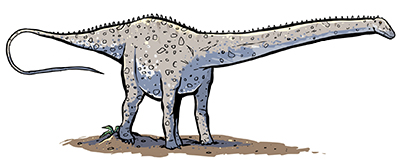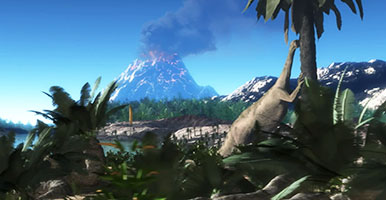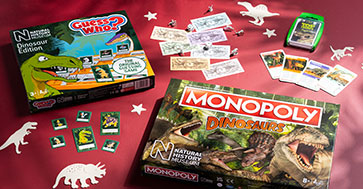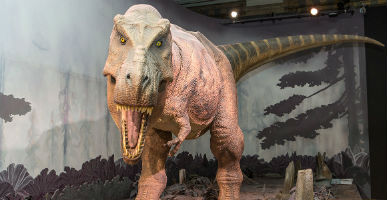Diplodocus
Diplodocus
- Pronunciation:
- DIP-low DOCK-us
- Name meaning:
- 'double beam'


- Type of dinosaur:
- sauropod
- Length:
- 26.0m
- Weight:
- 15000kg
- Diet:
- herbivorous
- Teeth:
- rows of teeth like a comb
- Food:
- leaves from trees and soft plants
- How it moved:
- on 4 legs
- When it lived:
- Late Jurassic, 152-145 million years ago
- Found in:
- USA
Diplodocus had a long neck that it would have used to reach high and low vegetation, and to drink water. There has been some debate over how such a long neck would have been held.
Scientists now think that ligaments running from the hip to the back of the neck would have allowed Diplodocus to hold its neck in a horizontal position without using muscles. The vertebrae (back bones) are split down the middle and this space could have held ligaments like these.
Diplodocus may have had narrow, pointed bony spines lining its back.
A Museum icon
In 1905 a cast of a Diplodocus skeleton was donated to the Museum by the wealthy businessman Andrew Carnegie, based on the original specimen in the Carnegie Museum in the USA.
King Edward VII had requested a copy of the newly discovered dinosaur after seeing a picture of it in Carnegie's Scottish castle. From 1979 to early 2017 the cast - known affectionately as Dippy - was on display in the Museum's Hintze Hall.
In 1993, Dippy's tail was lifted from the ground after research revealed that Diplodocus tails would have been raised high to balance the neck.
Every two years or so, our experts used specialist equipment to clean the 292 bones that make up Dippy. It took two staff two days to clean and maintain the cast for future generations to enjoy.
In January 2017, Dippy left the Museum to prepare for a natural history adventure across the UK. After returning in 2022, the famous cast is now on display at the Herbert Art Gallery & Museum in Coventry, on long-term loan from the Museum.
Taxonomic details
- Taxonomy:
- Dinosauria, Saurischia, Sauropodomorpha, Sauropoda, Eusauropoda, Neosauropoda, Diplodocoidea, Diplodocidae
- Named by:
- Marsh (1878)
- Type species:
- longus

Step back in time
Find out more about dinosaurs' lives and the world they lived in.

Fun and games
Learn more about dinosaurs through toys, board games and activity kits, available from our online shop.

Dinosaurs gallery
Roarrr. Come face-to-face with some of the Museum's most famous dinosaurs.




